At this early stage I apologise for the quality of writing. These blogs are things I have been meaning to get off my chest for a while. If I don’t try articulating these thoughts now then others things will pile up and they will be lost and unable to be furthered. So due to a rush of time, which exacerbates my dyslexia, I ask for a focus on content not style.
If you were to believe a lot of literature you would believe that the painter is a necessarily myopically focused individual, with each epoch only capable of seeing one capability of paint.
Pliny and Vasari wrote extensively about the use of paint as a mimetic tool. Pliny records famous anecdotes of the legendary classical painter’s ability as alchemists; able to make paint deny itself and become the total illusion of some other substance or object. The famous story which is so parodied throughout Art History is of course the Grapes painter by Zeuxis, which seemed so real the birds came down to peck at them. We of course have to take the artists desire to deny his medium with a pinch of salt, Pliny uses the stories to aggrandise the artists ability. Vasari continues the diatribe with his length Lives of the Artists, constantly painting a picture of paint being subservient to design, of paints purpose being entirely mimetic.
If we take this as the monolithic construction against which Modernism works then suddenly the pursuit of many 20th Century painters appears to be equally singular in the other direction. We return to the Greenebrg notion that painting will only survive by a celebration of its independent properties, an inward looking focus on itself, paint as paint and nothing else.
Even when painters still work with imagery we are told the subject and image is entirely superfluous. That it is merely an empty vessel to pursue some formal ends. How convenient. Don’t tell me William De Kooning was not interested in the figure, in flesh, in the sexuality of his subject. His was certainly not only interested in the medium for its own ends.
At a somewhat waffley pace this brings me to my point. Many, most, perhaps all painters have always been fascinated by the semiotics of paint. Such a term as semiotics is of only available after the linguistic theorising of Saussure. Whilst the term was not invented the notions, even if unarticulated, would have been pertinent to all painters. The logic is that no sign is singular. We only understand the meaning of a specific sign (be it an image, a substance or a word) due to its context. The specific signification of the sign only reveals itself when placed in context. Remove it from that context and it changes its meaning entirely. It’s all relative!
+pasted+papers,+gouache+and+chacoal+on+paper..jpg)
It is perhaps in the Synthetic Cubism of Picasso and Braque where this is most openly explored and with unbelievable sophistication. From 1911-13 Picasso and Braque out did each other one by one in finding ways to destabilise pictorial signs. The high point in my eyes is Picasso’s ‘Guitar and Wineglass’ fall 1912. (Other high points are ‘bon Marche’ 1913/14, ‘Guitar Maquette’ and Braques ‘Fruit Bowl with fois bois’) In Picasso’s humble masterpiece so much is turned on its head. Much has been made of the newspaper cutting at the bottom of the page. ‘Les Bataille sans engage’, it reads. That frustrating strain of literature which searches for specific sociological interpretation has taken this cutting back to its original source, a newspaper article about the outbreak of War in the Balkans. Others have seen it as self referential, as referring to the battle between Picasso and Braque. If either reading is singular the second makes more sense, with the works being for a private rather than public audience. Any public political dissenting voice becomes less likely. What these writers searching for certainty forget is that everything about the work looks to destroy certainty. It is a conscious exploration in the multiplicity of a signs meaning. So why do they try and tie this one aspect down. Whilst the argument continues you can imagine Picasso chuckling in his corpse.
In the centre of the page a white disc sits on top of the pasted collage of cuttings. It is the whitest and furthest forward of all the elements. We read it as something quite different however. Due to its context between edges which read as the side of a guitar we read it as the sound hole of said guitar. Thus is read as a black hole, the deepest point of the composition. The sign becomes a signifier of its total opposition. The same game is played with the wallpaper. The same paper is pasted across the whole surface. To the left of the guitar it reads as a wall in the background. In the centre of the work it reads as the body of the guitar. Without having done anything to it, but affected its surroundings, Picasso is able to make a flat plane of pattern shift between spatial registers.
It is at this moment I believe that a conscious play between a sign and its signification is played. What I want to consider is the notion that in reality, in the case of paint, this kind of game has always been going on. To be able to use and explore the medium for a range of signification is not the privileged position of the post Greenbergian student.
In considering its various uses across the history of Painting (across in a loose sense due to my limited knowledge at this moment in time) I hope to demonstrate that there is something permanent about painting, which ensures that principally it does not change. Rather than a reason for its demise it is the reason for its survival, in the past, present and future.
The specific notion I want to look at is the history of painters who explore, without contradiction, paints ability to reference a range of things. Paint as a mimetic tool, a self referential and decorative substance, an expressive medium and a symbolic spiritual signifier.
When considering paint as a mimetic tool people still seem to buy into the Vasarian doctrine. Without traipsing over old ground Vasari states that Design, as a masculine and intellectual facet of the arts’ it’s the solid base of a painters profession. Colour (paint) is seen as the final decoration of the solid linear design. As such the paint itself is not, according to the ‘gospel’ where the image is found.
The Venetians are credited with being the school which moved away from this. It has been cited as a revolution brought about by the conditions of their practise. The geography of Venice meant Oil paint on Canvas became the norm. From here artists like Bellini and particularly Giorgione moved towards a new mode of practise in finding image. They seem to have moved in a direction suggested previously by the writings of Da Vinci. It would be interesting to know if there was any awareness of his theoretical and occasionally practical precedent.
Before trying to deal with the exact evolution it is important to realise the restrictive nature of a discussion of this kind. To reduce the History of art down to this polemical dichotomy is makes things easier to understand but is ultimately false. There was a clear Central Italian Venetian divide, and it was evident in both the work and the theorists. For Central Italy read Desegno and for Venice read Colorito. (The verb to colour not the word colour. The difference between the locations is not a case of colour but a case of process, with premeditated design being one and the discovery through application the other) However singular Vasari is it is clear the divide is less black and white then he makes out. Even Michelangelo, Vasari’s demi god, shows a kind of painterly appreciation in his late drawings and sculpture. In his unfinished sculpture we see he actually tackling the stone, searching for the figure from it’s very substance. He speaks eloquently about it in his poetry (if my memory serves me correctly). In his late Crucifixion drawings the pencil seems to continuously follow the body of Christ in some kind of hypnotic hymn. He seems to search for the form in some meditative process. I digress but merely to stress any generalisations are inappropriate. It perhaps enhances the fact that all, even the most clearly design based of artists follow a mimetic process which succeeds because of rather than in spite of the medium.
Back to Titian…Of the painters who I am fascinated by Titian is the first who I would call truly painterly. It is from this tradition that I have pretensions of following, a kind of permanent history of people interested in the same mimetic philosophy. For Titian, as for those who follow, the form is found from the medium itself, rather than form constraining the medium; it a case of priorities. We associate this aspect of Titian to his late career, but it is in evidence very early on. In his ‘Concert Champetre’ 1509-11 (often attributed to Giorgione, incorrectly I believe) the glass jar held by the nude on the left is evoked with a couple of dashes and a wash of translucent paint. These marks are all that is needed to give an impressive sense of solidity and transparency. It is an economy of means which he would spend the rest of his career developing and perfecting.

For me Titians process reaches its peak in his evocation of flesh. Whilst many of the clichés with Titian are obtuse the fact he delighted in flesh and its evocation holds true. As we move throughout his career there is a tendency towards the destruction of plastic solidity. Under drawing becomes progressively more schematic, edges become less defined, atmosphere and form begin to coexist. In his uncompleted epitaph ‘Pieta’ 1570’s we see the body of Christ constructed from a series of broken brush strokes. Form seems on the verge of breaking into light and light and substance seem to transmute into form in front of our eyes. It is a gradually less descriptive and more poetic approach.

Titian delights in the very properties of the medium and their ability to stand for the alluded form, texture and image. The oily sensuous properties of oil paint are delighted in, used to convey the comparable qualities of flesh. The physicality and tactile nature of the substance is celebrated in a fleshy delight. Paint is pulled around, the surface caressed; the act seems to be actively searching for the moment resolution is found. In the final works the paint does not just seem to stand with paint but seems alive, fulfil the classic miraculous anecdote that his paintings only lacked breathe. This feeling is create4d by the way colouristic and textural vibrations are created through and across the multiple layers of paint. It creates a sense that the flesh is breathing, moving, alive. The sense of life is found in the paint itself and its very application.
Similar sentiments could be applied to a history of artists who seem to have directly spawned from the Venetian master. Rubens is a direct descendant, actively copying numerous Titians, absorbing his techniques through osmosis. Then follows Velasquez, Rembrandt, Reynolds, Goya, Delacroix, Courbet, Manet, Turner, Rothko, De Kooning, Aurbach, and more recently I spoke at length in my dissertation about Brian Graham being one of many current painters who continue from this past.

I have a real desire to follow this path and be able to find image and form in the process. To find that moment when the medium shifts and becomes form. I believe there are aspects of ‘Image and Form, a prelude’ where I am moving in the right direction.

Beyond Mimetic ends artists have long celebrated paint for various other meanings. The most obvious, to eyes trained on 20th Century painting, of these features is the self referential and decorative. The kind of features we normally associate primarily to ‘abstraction’. There seems to be no need to discuss the lists of 20th Century artists who celebrated the decorating of the flat canvas. My point here is to demonstrate aspects of painting which are permanent and which are not necessarily normally attributed to artists of a certain period. What I want to consider is the range of artists before abstraction who had a clear fascination with the spreading of colour on a two dimensional support, artists for whom that was a key ingredient, in its own rights, in the process. It is of course natural that it should be. All painters take a colour substance and push it onto a flat surface, thus all painters instinctively must take some delight in this actual process and its results, in the manner in which substance and colour hold to, sit on and play off the support. This is not and cannot be a delight only held by artists after 1900.
Again (due to lack of comprehensive knowledge) I will begin my discussion with the Venetians of the 16th Century. The context of the Venetians interest in the paint for its own merits is obviously tied up in the same conditions of practise and approach to their art that formed my discussion of Titians mimetic process. This is the crux of my blog; that for these artists meaning was found in the medium itself.
Titians fascination with the paint itself and its decorative properties is clear in his use of colour and medium. Throughout his career he shows awareness for the decoration of colour over the surface. Consider his ‘Assumption’, that great spread of red. It has a clear dramatic narrative aim; it is the theatrical device which takes our eye from the profane robes of the apostles through the rising Mary and up to god the father. In dragging our eye up the verticality of the mammoth work it replicate her dynamic ‘Assumption.’ Whilst its intention is for a narrative end it shows an acute awareness and celebration of colour on the surface.
In Titians later work the very presence of paint begins to be celebrated in a proto impressionistic manner. This is a common thread in all the painters I discuss. As we move forward in time they feel more and more liberated and happy to fully reveal the medium.
Out of all the artists I can think of it is perhaps Veronesse and then Delacroix who seem to move noticeably foresee the picturesque brilliance of the impressionists. In Veronesse’s work colour seems to be systematically placed across the surface. He seems to unite his various warm and colds and lights and darks and then almost like a composer ensure that they are scattered evenly across the surface. It is far more subtle and sophisticated than this crass explanation describes.

Delacroix, due to his time, is able to take a similar advance further. It is known he was thinking of artists like Veronesse when he made his breakthroughs. One of the big moments for Delacroix was his trip to Morocco. There the intense light made him realise how shadows and blacks in general, were filled with colour. He started to see the complementary of the local colour in its shadow. In works like ‘Women of Algiers’ we begin to see him break colour across the surface, to detach it from its contours. There are numerous great examples of how he does this more precisely, but with Lee Johnson already having described it so beautifully in his small book I feel no need to repeat with a far superior use of words.
What most interests me about these artists, and other similar ones, is what I consider to be a musical use of paint. They seem to user the substance and colour in such a way as to create rhythms, melodies and harmonies across the surface, each individual part like an instrument in an orchestral production. It reaches its peak when Monet is at his best but still reverberates in Rothko and Pollock and even Ian Davenport, each of who play very different tunes.
It is something I have consciously been trying to do since returning to painting. Rather than get lost in romantic notions of the creative process I have approached this task a bit more scientifically. I have begun to think carefully about colour. To take a mid colour and then move that colour in two directions, warmer and colder, darker and lighter. The two resulting colours I then use across the surface, depending of course on the particular nature of the painting in hand. What it ensures is a certain unity. You have parallel opposites if you like, where by your two poles are united by the same base colour.
The manner, in which you apply, density, pressure, texture, variety, size all affects the musical experience. What I have realised is that I am not the musician. I am the conductor or even the composer. You don’t paint at a certain speed in some contrived notion that that we create a certain rhythm. You have to place your notes (colour) and beats (paint) in a construction which then allows the eye to play them. Harmony, tension, speed can all be conveyed by an almost mathematical application. All of these elements are obviously used to support, if successful, the central narrative or subject. Yet the fact is, like with pure abstraction, they have autonomy, they celebrate themselves as well as looking beyond themselves for some other end. The harmonising of this autonomous end to the mediums other referents is something I will tackle at the end of this blog. For that, ultimately, is the moment of real success. When you can harmonise separate melodies.
At this moment in time I have been finding a real pleasure in certain brown (burnt umber) where you can add say Colbalt blue to create your grey and lemon yellow to create your warm glowing orange. These seem to sit with such balance next to each other, creating a real vibration across and through the surface.
If I am honest colour is something I have not paid enough attention to in the past. Discussion with Andy and the Howard Hodgkin exhibition seem to have made me realise its importance and to think more carefully about its use.
The discussion so far has focussed on the two most obvious facets of the mediums character, self referential and mimetic. Beyond these paint can be used as a highly expressive tool. This reaches deeper and further than some clichéd notions of expressionism. Painters have always been aware of colour, touch and surface as vital tools in striking an emotive note.
In order to avoid the crass generalisations I have already moved towards I will just provide two brief examples of two pre 20th Century painters who understood the emotive powers of the medium. What I hope to prove is that for these artists meaning could be found in the medium itself. Renaissance artists, for instance, were not merely limited to figural dynamics in order to be expressive.
Titian in ‘Tarquin and Lucretia’ 1572.

The painting is a scene of unimaginable horror which induces an intense emotive response. One of the many contributors to its effect is style. The erotic fleshy seductiveness of Lucretia’s flesh is an essential ingredient. It is what causes Tarquin to commit the heinous crime and its eroticism is what draws us into the intensity of the drama. It is the seed to the internal drama and our external response.
Colour and stroke are harnessed to evoke the terror. The violent and dramatic reds of Tarquin’s socks, the sexually charged violence of the purple loins and their broad handling, the splintered proto Pollock splattering which make up his top and speak of uncontrolled violence. The manner in which the dash of white not only evokes the knife but seems to capture the suddenness of its motion, almost as if its action repeats itself to the viewer. The manner in which Lucretia’s jewellery on her left wrist is juxtaposed to her hand, one solid and detailed the other soft and seemingly ephemeral, grasping in space in her tragically futile attempt to hold Tarquin back .
The human drama, the pure emotion is captured through the very medium itself.
Dealcroix’s ‘Death of Sardanapalus’ 1827

This painting retells Byron’s story of Sardanaplus, one of gross megalomania. Sardanapalus is determined to outlive all his possessions, including slaves and mistresses. With his impending death he orders all his possessions to be destroyed whilst he watches on.
In painting story needs to be told in one instance, across space, not with word over line. Sometimes a pictorial statement can be found to equate to a whole scene. In this case Dealcroix uses colour and line to evoke the chaos of the event. We see a scene which has been titled up to the surface. A mass of sensuous curves mount chemically across and up the surface, towards the apex where the cause of the mayhem is a spectator in a relaxed pose. Line has been destabilised and is no longer purely a mimetic signifier. The rhythm of line across the surface creates a Rubenesque form and energy which is continued by a similar musical use of colour, reds pouring in and out of the various curving shapes. What is evoked is the sense of chaos that is central to the pictures subject, one of uncontrolled, selfish meglomanic and material destruction. Yet it is still ordered. Compare it to the sketch and you can see the liens have been filtered, contained and controlled within a system.
Elsewhere Delacroix uses paint in a variety of ways in various works to creates various moods. He is fully aware of its sensuous qualities, of its range and ability to convey various emotions, from the calm, to chaotic, the melancholic, the brutal fight, longing and loss.
In this sense Delacroix and Titian are not unique. Many other artists, for many centuries, have used paint to evoke the emotive. Consider Rembrandt’s self portraits. In the very medium he seems to have found the weight of humanity. It is as if the multiple layers of paint and skin also contain time. As if the literal layering of paint equates to the implied age of the skin and the artist. The medium seems to have a philosophical weight which weighs heavy on the viewers mind.
This brings me neatly onto another use of paint. Paint as a symbolic form. The most obvious abstract symbolism in paint is when paint stands for light and that light stands for some spiritual being or notion. I am not talking about when an artist equates a localised colour with light, using say a bright yellow to represent a celestial realm. Whilst effective this is merely a poetic metaphor, one thing standing for another, a kind colouristic iconography which we understand due to our knowledge of past paintings.
What I am interested in when artists seem to be capable of actually imbuing the medium with real light. Titian does it in his later works (San Salvador Annunciation, Pieta, the later Crowning with Thorns and various other works) but Rembrandt is perhaps the supreme master of this particular craft. Consider his self portrait in the National Gallery.

The skin is made up of a series of impasto layers of paint. Over this translucent glazes of vibrating hues are laid over. The mechanics of paint are harnessed to create a self reflexive light. Light pierces the skin of paint and some is absorbed, some refracted and some reflected. What is created is a warm glow which comes from within and behind the painting. This is light beyond illusion, beyond metaphor. The significance is critical as the spiritual signification is far more potent and intense. It is exactly the root cause of the sense of the spiritual, of otherness, of the mystical and the possibility of transcendence opened up by a later artist such as Rothko.
I want to conclude by reminding myself what the point of this sprawling waffle was. I wanted to prove that singular histories have no place. The reality is always more faceted and fragmented than that.
I want to go back to Titian one more time and consider a particular painting and its reception in its original context, in part to prove my waffle has not totally been the projection of Modernist thinking.
Vasari spoke specifically about Titian’s late work and in particular the poesie for Phillip II of Spain. One of these works is the masterpiece, ‘Rape of Europe’ c1862

Vasari talks about Titians style in depth. He describes how from up close we cannot fully make out the image but when we stand back the forms come into complete vision. This confirms the two fold nature of Titian’s painting and shows how such a fascination is not the privilege of a post Greenbergian practitioner.
Up close we delight in many aspects of the open brushwork. The surface as a whole presents itself to us, the relationship between the rough weave, thin translucent layers and impasto layers of paint built up at different speed and finish. We delight in the abstract qualities of medium decorating the support.
The fish on which the Cupid is riding: The manner and variety of application, from thin to thick and how it equates to the alluded image. A thin glossy wash, the last layer, is seen as paint yet reads convincingly as the slippery skin of the fish.
Our eyes are attracted to Europe’s body, but to flesh not figure, to surface not image. The layered surface has a memory as is evidence to the multiple visits of the artists Boschini spoke about. In these layers we get a sense of the various speeds of the hands, the brush and fingers pushing the fluid paint around the dense surface. Our eye delights and caresses, like Titians hand, in the seductive nature of paint and flesh, the two virtually inseparable. In the open brushwork we see the organic nature of the process, where paint metamorphosis into flesh. The relationship between matter and form is revealed to us.
This journey continues as we stand back from the canvas.
Up close we were united in the search, standing back we, like Titian, discover the moment of transmutation. Matter becomes form and form becomes image, set in three dimensional space. The fluid marks unite to form Europa’s solid form. New sensations take over, poetic feelings of fear, danger and drama.
We are actively involved in the dynamics of viewing, which are linked directly to the mechanics of production. (One the cause of the object the other its effect). We become aware of the two fold nature between surface and image. There are two time signature. The self reflexive melody of the process and the implied narrative. The later is told through time and space. Moving from left to right and background to foreground we see Europa’s journey, from safe land to threatened and unbalanced position, heading across and perhaps out of the frame.
Titian, the composer, unites the two time signatures, two melodies harmonised.
Titian is the pinnacle of a history which was supposed to work singularly towards space and distance beyond the canvas. Yet here we show how at the same time he was aware of and celebrated the surface itself. The predicament of the Alberttian window was as complex for Titian as it is for a painter today. Never has it been singular.
The same is true when we get to the end of the opposing monolithic theory in the History of Art. Greenberg spoke about a clealr move towards flatness, and Pollock was supposed to be the pinnacle of this. Yet look at one of his great works such as ‘Lavender Mist, No 1’. They play on a spatial dichotomy. This goes against the notion of him as the icon of a high Modernism which espouses a dogmatic and singular aesthetic of flatness. In ‘Lavender Mist, No 1’ (Fig. 23) the rhythmical drips do create a sense of interlocking pattern dancing over the surface, celebrating its flatness. Equally, however, the lines create a web-like matrix which seems to pulse through the plane of the canvas. The series of lines are in a constant discussion between surface decoration and depth.

This I hope illustrates my point. For anyone whoever picked up a brush, filled it with a coloured medium and spread it across a flat surface the ability for that combination to have a large range of significations was open to them. The semiotics of paint is something which has fascinated every painter and will continue, above and beyond gimmickry, to do so.


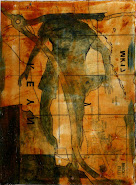

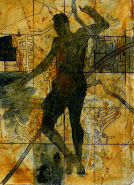

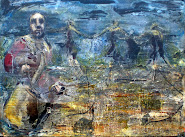

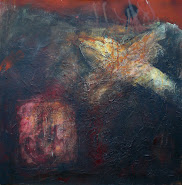

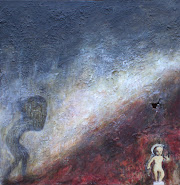

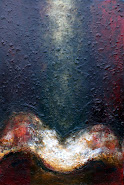

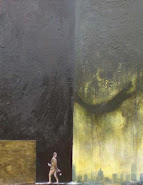



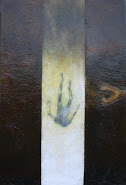





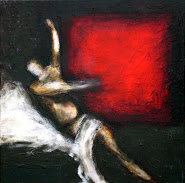


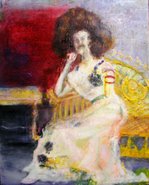
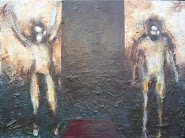


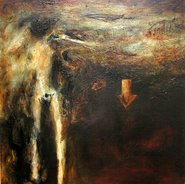
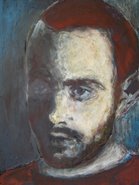
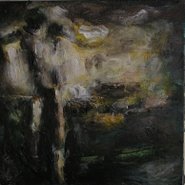
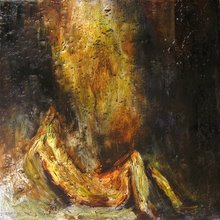
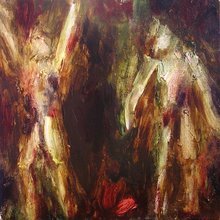
1 comment:
testing, testing... one two three. Checking comments can now be published easily. Tdf
Post a Comment